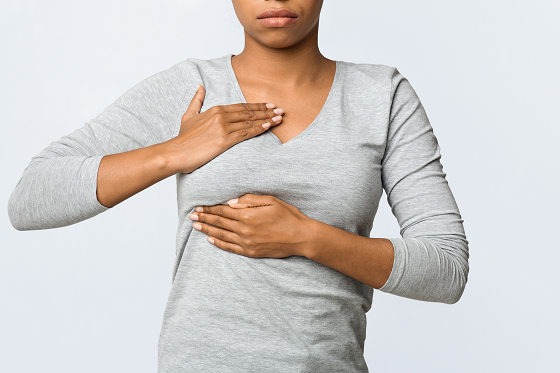
Breast cancer: an easy guide to self-examination
It’s October! Have you touched yourself yet?!
In case you are wondering, October is Breast Cancer Awareness month.
Breast cancer self-examination is a simple, useful screening technique that can be done in the comfort of your home. While breast cancer can be treated at all stages, one must understand the importance of diagnosing it early. Always remember that early detection can save lives.
Step 1:
Remove your top including your bra and look at your breasts in the mirror. Your shoulders should be straight and your hands on the hips.
Breasts are evenly shaped without visible distortion or swelling.
If you see any of the following changes, visit a hospital immediately:
- Dimpling or indentations (think of an orange with an uneven skin)
- Bumpy Protruding sections of the breast
- The nipple that has changed position or an inverted nipple (pushed inward instead of sticking out, skin with redness or rash.
- Changes in skin color over your breasts
Note that a mild variation in sizes of both breasts is considered normal. In the same way, can testicles vary in size.
Step 2:
Raise your arms and look for the same changes as mentioned in step 1.
Step 3:
While you are in front of the mirror, gently squeeze your nipples to check for discharge. If you notice a watery, milky, or yellow fluid or blood discharge, consult with your doctor.
Step 4:
Examine your breast while lying down. In this step, you need to raise your right hand to examine your left breast and then raise your left hand to examine your right breast. Using the flat pads (tips) of your first few fingers (could be index, middle, or ring fingers), gently but firmly press your breast in circles or in a circular motion.
Do not place parts of your breast between your thumb and index finger to feel it. Start from your collarbone till you reach the bra line (upper part of your breast where bra reaches). Move your fingers in circles, either up and down or sideways towards your nipple. Further, carefully examine the areas between your breast and armpit.
Switch arms and repeat the step with your other breast. Gently feel for a lump or thickening. Be sure to check every part of your breast.
Step 5:
Feel your breast while you are standing or sitting using the same instructions as mentioned in step 4. Breast self-examination is all about TLC (Touch, Look, and Check).
Many women find that it is easier to feel their breast when the skin is wet and slippery hence they prefer to do the self-examination in the shower.
What to do if I find a lump?
Do not panic. This does not automatically mean you have breast cancer. Some lumps are not cancerous. Stay calm and immediately report your findings to a health care provider in your preferred health care facility.
Breast self-examination can pick up cancer at a very early stage. The ideal day to undertake the self-examination is a few days after your monthly menstrual cycle ends. Postmenopausal women can choose any day in a month.
Women aged 40 and above though must make breast self-examination a monthly routine to keep track of any new developments in the breasts. This is because the risk of getting breast cancer increases with age.
It is important to note that breast self-examination is not a substitute for a mammogram.
A mammogram reveals a breast lump even before it can be felt. Annual screening with a mammogram is recommended for women who are 40 years and above. Become familiar with how your breast looks and feels so that you can notice any changes

cute
cute
Thank you Precious!
Thank you Precious!
Soo educational
Soo educational
I am glad that you found it…
I am glad that you found it educational Angela! Keep it here for more educational content!
I’ve learnt a lot..thank u
I’ve learnt a lot..thank u
You’re welcome Mercy!
You’re welcome Mercy!